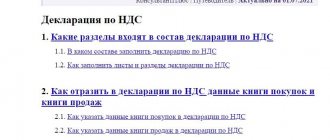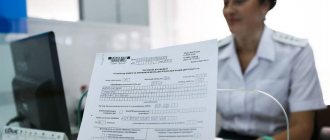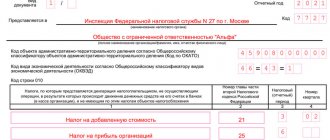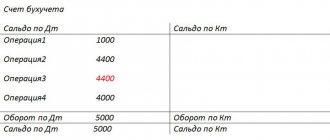Article 80 of the Tax Code of the Russian Federation gives the following description of a tax return - this is a statement about the objects of taxation, income received, expenses incurred and the calculated amount of tax. Tax return forms for various taxes are approved by the Federal Tax Service, so, of course, this is not a document that can be drawn up in free form. In addition to the declaration forms themselves, the Federal Tax Service also approves the procedure for filling them out. Quite often, taxpayers make mistakes when preparing returns.
To avoid this, we recommend contacting specialists in a timely manner if questions arise, and also monitor the submission of reports. You can check yourself with a free audit.
Check your accounting for free
You can download current forms of tax returns and other necessary documents in the Document samples section
What should you do if you discover an error after submitting your return? You may have to prepare and file an amended tax return. In some cases, filing it will be a right of the taxpayer, and in others – an obligation.
What is considered an error in the declaration
Article 81 of the Tax Code of the Russian Federation mentions inaccurate information in the declaration and errors themselves. Inaccurate information is incorrectly indicated amounts of income, expenses, results of financial and economic activities, taxes payable. Errors mean an incorrectly specified tax period or date, arithmetic errors, violation of the procedure for filling out the declaration, incorrectly specified codes (TIN, KPP, KBK, OKTMO, etc.) .
Inaccurate information and errors in declarations may not in any way affect the amount of tax that must be paid, but may reduce or increase it. The need to file an updated tax return depends on how errors and inaccurate information affect the tax amount.
The procedure for filling out the updated 3-NDFL declaration
The procedure for filling out the updated 3-NDFL declaration is as follows:
- fill in the taxpayer’s TIN, his last name, first name and patronymic and the period for which the declaration is being submitted;
- enter the correction number. If the updated declaration is being submitted for the first time, you must enter “1- -”. If it is necessary to clarify the declaration again at a later date, the adjustment number will already be indicated as “2- -”.
- then fill out the declaration, indicating the correct data. In this case, it is necessary to act as if the declaration is being filled out for the first time, i.e. do not supplement/correct previously submitted data, but fill out the declaration with completely correct data;
- put your signature and the current date (date of filling out the declaration).
Just like any other declaration, the updated declaration can be filled out either by hand or by electronic means (
When is a taxpayer required to file an amended tax return?
Everything is very simple here, if the amount of tax payable is underestimated, that is, the interests of the budget suffer, then filing an updated declaration is the responsibility of the taxpayer (clause 1 of Article 81 of the Tax Code of the Russian Federation). If errors in the initial declaration did not reduce the amount of tax or an overpayment to the budget occurred, then the taxpayer has the right, but not the obligation, to submit an updated declaration.
The period for which an update can be submitted is not limited by law. Even if more than three years have passed since the filing of the erroneous return (the depth of the on-site audit), the taxpayer is required to file an updated return if he has discovered a tax arrears.
Please note that the taxpayer must detect errors or inaccurate information in the primary declaration on his own . If they are found by the tax inspectorate as a result of an audit or reconciliation of calculations, then the amounts of arrears or overpayments of tax are recorded in the results of the audit.
As for overpayment of tax to the budget, before submitting an updated tax return, it is worth assessing the feasibility of this step. The fact is that if the tax base is understated (that is, the tax was overpaid as a result of overestimating income or understating expenses), the tax inspectorate can conduct an on-site audit for the period for which the updated tax return was filed.
In addition, to confirm the fact of overpayment of tax, it will be necessary to submit to the Federal Tax Service the documents on the basis of which the updated declaration has been prepared (agreements with counterparties, primary and payment documents, invoices). If you are sure that you are right, you can confirm it with documents, and the amount of overpayment is significant, then it is really worth submitting an amendment.
Procedure for detecting errors or inaccuracies in the 3-NDFL declaration
Let's decide what to do in this case:
- It is necessary to determine whether errors or inaccuracies in the previously submitted 3-NDFL declaration resulted in underpayment of tax to the budget. If this is the case, then the data in the declaration must be corrected and an updated declaration must be submitted to the Federal Tax Service. If not, the taxpayer also has the right to submit an updated declaration to the Federal Tax Service. But this is precisely his right, not his obligation.
- It is necessary to fill out a detailed declaration in form 3-NDFL. It should be remembered that the legislator often makes changes to the declaration form. Therefore, you first need to make sure that you select the declaration form that was in force during the period when errors or inaccuracies were made when filling it out.
- Next, you need to submit an updated declaration to the Federal Tax Service. If necessary, supporting documents must be attached to the declaration.
- If errors or inaccuracies in the initial declaration resulted in an underpayment of personal income tax to the budget, the underpaid amount of tax must be paid.
How to file an updated declaration
There is no special form for the updated declaration, but here it must be taken into account that the corrected information must be submitted on the form that was in force during that tax period (clause 5 of Article 81 of the Tax Code of the Russian Federation). For example, if in 2022 you discovered an error in the declaration under the simplified tax system for 2022, then you must submit an updated declaration in the form that was relevant in 2022.
The updated declaration does not indicate the difference between erroneous and correct values, but only the new correct indicators. The title page will also be different, since a different correction number must be indicated on it. In the initial declaration, “0” is written in the field with the adjustment number; in the first updated declaration it will be “1”. If another clarification is submitted during the same period, then the value of the corresponding field will be “2”, etc. The number of clarifications of the declaration is not limited by law.
If you are submitting an updated declaration for the period before January 1, 2014, when OKATO codes were in effect (they have now been replaced by OKTMO codes), then indicate exactly them. But if, on the basis of this adjusted declaration, you must pay arrears of tax for the period before 2014, then only the OKTMO code can be indicated in the payment order.
The Tax Code does not require any explanations to be attached when submitting an updated declaration; however, it is recommended to submit an explanatory note along with it. All the same, the tax office will most likely ask for an explanation during a desk audit of the amended declaration.
In your explanatory note please indicate:
- what tax return you are submitting and for what period;
- what inaccurate information or errors are contained in the primary declaration;
- in which fields of the updated declaration the primary and corrected values of the indicators are indicated;
- calculation of the tax base and calculated tax (if these amounts have changed);
- copies of payment documents confirming payment of arrears and penalties, if they were paid before filing the updated declaration.
Submission of an updated 3-NDFL declaration to the Federal Tax Service
The updated declaration is submitted to the Federal Tax Service with the attachment of documents confirming the newly entered (corrected) data.
Regarding the resubmission of documents that were submitted to the Federal Tax Service with the initial declaration, the following must be taken into account. The Federal Tax Service can only request these documents again in two cases:
- in case of loss by the Federal Tax Service of previously submitted documents
- if the previously submitted originals were returned to the taxpayer, and only their copies remained with the Federal Tax Service.
The updated tax return is submitted at the taxpayer’s place of residence.
You can submit an updated declaration either in person (directly to the Federal Tax Service, or by sending it by mail) or through a representative. In this case, the representative must have a notarized power of attorney.
In this case, two copies of the declaration are filled out so that the taxpayer has one copy with the Federal Tax Service Inspectorate marking the acceptance of the declaration.
As a recommendation, we can advise you to attach an explanatory letter to the declaration, in which you explain the reasons that prompted you to submit an updated declaration and list all the attached documents. The letter must also be drawn up in two copies.
You can also send an updated declaration electronically through the government services portal or the taxpayer’s personal account.
The deadline for submitting an updated declaration is not established by law, so it can be submitted at any time after an error/inaccuracy is discovered (
Responsibility for filing an amended tax return
Of course, taxpayers are concerned whether any sanctions may be applied to them for filing an update. Maybe it’s better to wait until the tax inspector discovers these errors and false information on his own (but he may not find it)? Or, after all, the sword does not cut off a guilty head? Not always.
There is no liability for the fact of filing an updated declaration. However, depending on the deadline for its submission and the presence of tax arrears (if, upon clarification, the tax amount turned out to be higher than in the initial declaration), the following situations may arise:
- The corrected information was submitted within the reporting campaign deadlines. For example, on February 10, 2022, the organization filed an initial declaration under the simplified tax system for 2022, in which errors or inaccurate information were quickly discovered. If the updated declaration is submitted by the end of March 2022, then no negative consequences will arise at all. In this case, it is recognized that the initial declaration was submitted on the day the amendment was submitted.
- The deadline for submitting the declaration has passed, but there is still a deadline to pay the tax. There will be no sanctions against the taxpayer unless he found the error himself and did not learn about it as a result of a desk audit of the primary declaration or from a message about the appointment of an on-site audit. And, of course, the tax must be paid on time.
- The deadlines for submitting the declaration and paying the tax have expired. Important - before submitting an updated declaration, you must pay the amount of arrears of tax and penalties (clause 4 of Article 81 of the Tax Code of the Russian Federation). In this case there will be no fine.
- A situation where a fine for violating tax calculations cannot be avoided - if the taxpayer learned about false information or errors that underestimated the amount of tax from the tax inspectorate. In addition to tax arrears and penalties, you will also have to pay a fine under Art. 122 Tax Code (in the amount of 20% of the unpaid tax amount).
Payment of tax according to the updated 3-NDFL declaration
When submitting an updated declaration with a larger amount of personal income tax payable than was in the original declaration, the difference must be paid to the budget. It is better to do this no later than the day the declaration is submitted in order to avoid the accrual of tax penalties. If, after submitting the updated declaration, the payment is not made, the Federal Tax Service will issue a demand for payment of tax, penalties and fines.
If payment on demand is not made, the Federal Tax Service may apply to the court to collect the tax and tax penalties due from the debtor’s property.
How to track
Keep in mind that you can monitor the progress and deadline of the 3-NDFL desk audit on the official website of the Federal Tax Service in the personal account of an individual. There the system shows the percentage of verification of the submitted declaration. Every day it gets bigger. However, this does not mean that the inspectorate analyzes your report several lines a day.
The fact is that in your personal account, the progress of the 3-NDFL audit is reflected in the form of a calculated percentage of 3 months - from the date of the start of the desk audit to the current date.
Results
- If the 3-NDFL declaration is submitted with errors or incomplete information or its absence , then you can submit an updated report with explanations and new documents.
- The adjustment declaration must have the same form as the original one, and differ in content only in those parts that have been changed.
- For mistakes, you may be subject to tax sanctions , but in the cases specified in Article 81 of the Tax Code of the Russian Federation, the citizen is exempt from liability.
- After adjusting 3-NDFL, you need to wait another 3 months for the completion of a new desk audit.
Main errors in the VAT return and ways to eliminate them
The sales invoice was not reflected in the sales book
Be sure to submit an amendment, as you have underestimated the amount of tax payable. We register the forgotten invoice on an additional sheet of the sales book in the quarter when the sale occurred.
In the clarification, we fill out Appendix No. 1 to Section 9. In term 001 of the Appendix we write “0” and transfer the data from the additional sheet of the sales book.
Before submitting the declaration, we pay additional VAT and penalties, otherwise the tax authorities will issue a fine.
Understatement of VAT due to a technical error in the invoice
We ask the seller to issue a corrected invoice. In the additional sheet we cancel the incorrect invoice and register a new one. We write the amount for the canceled invoice with a minus sign, and for the corrected invoice with a plus sign.
The indicator of relevance in sections 8 and 9 is “1”, and in Appendix No. 1 to section 9 – “0”.
Duplicate invoice in sales book
On an additional sheet we write down the “double” invoice with a minus sign, that is, we cancel it. In sections 8 and 9 we indicate the relevance indicator “1”, and in Appendix No. 1 to section 9 - “0”.





